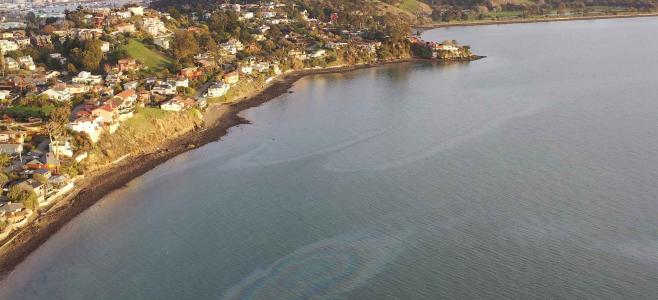Baykeeper’s advocacy helped win new rules to reduce the risk of oil spills in San Francisco Bay by keeping large outbound ships from passing under the Bay Bridge in heavy fog.
The rules were adopted by the San Francisco Harbor Safety Committee February 14 and the Coast Guard announced that they were in effect immediately. Oil tankers, cargo ships and other large vessels are now prohibited from sailing out of the Bay when visibility is less than a half mile.
I serve on the Harbor Safety Committee, representing the public and the Bay, and I applaud the committee’s swift action in the wake of the January 7 accident, when the oil tanker Overseas Reymar crashed into the Bay Bridge. Visibility at that time was only a quarter mile. The tanker’s cargo tanks were empty, but it was carrying 245,000 gallons of bunker fuel used to run the tanker itself. It was a relief that the crash didn’t pollute the Bay, but this near-disaster made it clear that the Bay needs better protection from oil spills.
The new rules apply only to ships leaving the Bay. Inbound ships will be able to enter the Bay in foggy conditions, but they must use extreme caution. Baykeeper supports this, because it would be far less safe to have large ships circling just outside—or inside—the Golden Gate, waiting for fog to lift.
Baykeeper has been the lead environmental advocate for more protection for the Bay from oil spills since the Cosco Busan container ship hit the Bay Bridge in November 2007. That crash spilled more than 53,000 gallons of bunker fuel, killing thousands of birds and polluting Bay shorelines and nearby ocean beaches.
After the Cosco Busan disaster, Baykeeper advocated for rules to prevent future similar crashes, and many parts of the Bay were put off limits to large ships during fog. The Bay Bridge, however, was not included at that time.
Now, under the rules adopted this week, ships have to first radio their location and report any low-visibility to the Vessel Traffic Service, which oversees the Bay in a way similar to air traffic control at airports. The ships will be allowed to head out, by passing through the two widest spans between towers, only if visibility is greater than a half mile.
Baykeeper is continuing our ongoing investigation of the January Overseas Reymar crash. As we learn more, we plan to advocate for additional changes to give San Francisco Bay better protection from oil spills.
Read more about the January collision between the oil tanker and the Bay Bridge.
Read more about the new rules to protect the Bay from oil spills.


